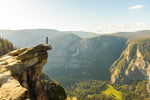Brandon Currin
Surviving a Bear Encounter: Dos and Don'ts for Bear Country
The great outdoors offers a sense of freedom and adventure that's hard to match. However, it's also home to wildlife, including bears. Encountering a bear in the wild can be both awe-inspiring and intimidating. While such encounters are rare, knowing how to react can make the difference between a memorable experience and a dangerous situation. This comprehensive guide will provide you with the dos and don'ts for surviving a bear encounter in bear country.
Understanding Bear Behavior
Before we delve into the dos and don'ts, it's crucial to understand bear behavior. Bears are typically solitary creatures and prefer to avoid humans. Most bear encounters occur when bears are surprised or feel threatened. They are also more likely to approach humans if they associate them with food. Understanding these behaviors can help you avoid unwanted encounters and react appropriately if you do come across a bear.
Bears are not naturally aggressive towards humans. However, like any wild animal, they will defend themselves if they feel threatened. Mother bears are particularly protective of their cubs and may react aggressively if they perceive a threat.
Dos and Don'ts in Bear Country
When you're in bear country, there are several things you should and shouldn't do to reduce the risk of a bear encounter:
Do:
Make Noise
Making noise is a simple yet effective way to avoid surprising a bear. When you're moving through dense vegetation or near running water, where your presence might not be obvious, it's particularly important to make a bit of a racket. Talk loudly, sing, or carry a bear bell. Some hikers even recommend carrying a small air horn. The noise alerts bears to your presence, giving them a chance to avoid you. Remember, most bears prefer to steer clear of humans, and giving them the opportunity to do so can prevent many bear encounters.
Carry Bear Spray
Bear spray, a type of pepper spray specifically designed to deter bears, is an essential tool when you're in bear country. It can stop a bear in its tracks during an attack, giving you time to escape. However, it's not enough to simply carry bear spray—you need to make sure it's easily accessible (not buried in your backpack) and know how to use it. Practice with a dummy canister so you're prepared to use it in an emergency. Familiarize yourself with the spray's range and the way it disperses, so you're not caught off guard if you need to use it.
Travel in Groups
Bears are less likely to approach larger groups of people. If possible, travel with others when in bear country. The combined noise and size of a group can deter bears. Plus, multiple sets of eyes can be beneficial in spotting bears from a distance, allowing you to reroute and avoid an encounter altogether.
Keep a Clean Camp
Bears have an excellent sense of smell and can be attracted to your campsite by the smell of food, garbage, or even toiletries. Store these items properly to avoid attracting bears. Use bear-resistant containers and hang your food at least 10 feet off the ground and 4 feet from any vertical support. Clean up all food scraps and trash, and change out of clothes you wore while cooking before you go to sleep. A clean camp is less likely to attract bears and can prevent a late-night bear visit.
Don't:
Don't Approach Bears
If you see a bear, keep your distance. Never approach a bear to take a photo or get a closer look. Bears are wild animals and can be unpredictable. Approaching a bear can make it feel threatened and provoke an attack. Instead, use binoculars or a telephoto lens to view and photograph bears from a safe distance.
Don't Run
If you encounter a bear, resist the urge to run. Running can trigger a chase response, and you can't outrun a bear. Instead, back away slowly and diagonally. Speak in a calm, firm voice while avoiding direct eye contact, which can be perceived as a threat.
Don't Feed Bears
Feeding bears can make them associate humans with food, increasing the risk of future encounters. It's also illegal in many places. A fed bear can become a nuisance or even a danger to people and may have to be relocated or euthanized. For the sake of both bears and people, keep your food to yourself.
What to Do If You Encounter a Bear
If you do encounter a bear, how you react will depend on the situation and the type of bear. However, here are some general tips:
- Identify Yourself: Speak calmly and firmly. This can help the bear recognize you as a human and not a prey animal.
- Stand Your Ground: If a bear approaches you, stand your ground. Slowly wave your arms to make yourself look bigger.
- Use Bear Spray: If a bear gets too close, use your bear spray. Aim for the bear's eyes and nose.
Understanding Different Types of Bears
Different types of bears may require different responses. Here's what you need to know about the most common types of bears you might encounter:
- Black Bears: Black bears are generally less aggressive than grizzlies. If a black bear approaches you, try to scare it away by making yourself look bigger and making loud noises.
- Grizzly Bears: Grizzly bears are more likely to attack if they feel threatened. If a grizzly bear charges you, use your bear spray. If you don't have bear spray and the bear makes contact, play dead. Lie flat on your stomach with your hands clasped behind your neck and spread your legs to make it harder for the bear to flip you over.
- Polar Bears: Polar bear encounters are rare but can be very dangerous. Avoid polar bear habitat whenever possible. If you do encounter a polar bear, use your bear spray and try to escape to a secure place.
Conclusion
Encountering a bear in the wild can be a nerve-wracking experience, but with the right knowledge and preparation, you can safely navigate bear country. Remember, the goal is not just to survive a bear encounter, but to avoid one in the first place. By respecting bears and their habitat, we can coexist with these magnificent creatures and continue to enjoy the beauty.
Image by Håkan Carlander from Pixabay
Share on:










